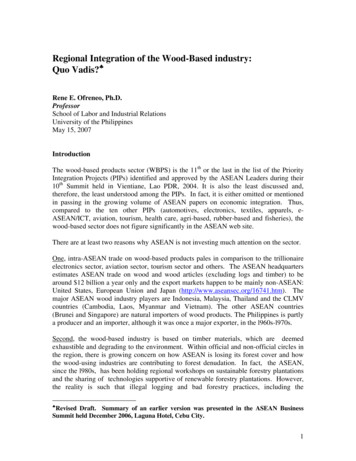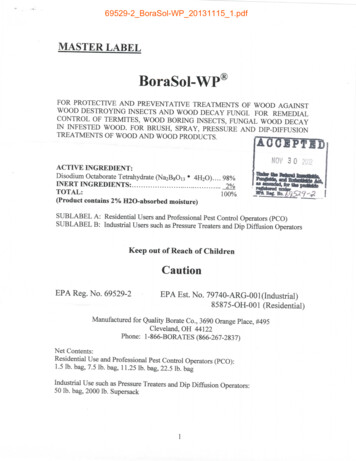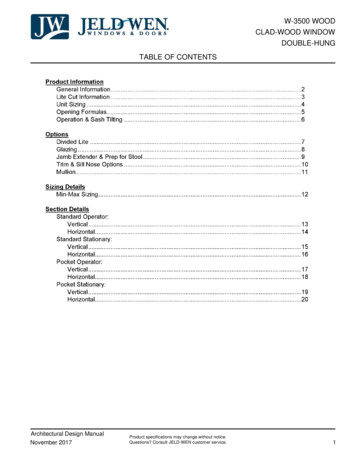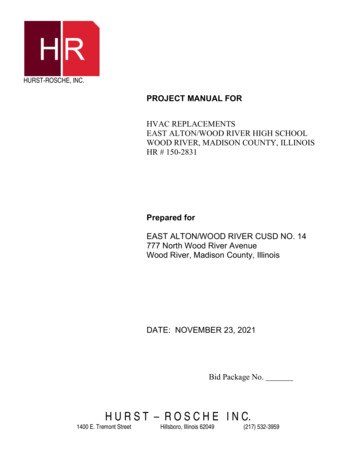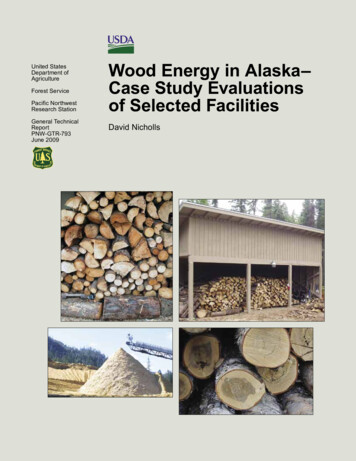
Transcription
United StatesDepartment ofAgricultureForest ServicePacific NorthwestResearch StationGeneral TechnicalReportPNW-GTR-793June 2009Wood Energy in Alaska–Case Study Evaluationsof Selected FacilitiesDavid Nicholls
The Forest Service of the U.S. Department of Agriculture is dedicated to the principle ofmultiple use management of the Nation’s forest resources for sustained yields of wood,water, forage, wildlife, and recreation. Through forestry research, cooperation with theStates and private forest owners, and management of the National Forests and NationalGrasslands, it strives—as directed by Congress—to provide increasingly greater serviceto a growing Nation.The U.S. Department of Agriculture (USDA) prohibits discrimination in all its programs andactivities on the basis of race, color, national origin, age, disability, and where applicable,sex, marital status, familial status, parental status, religion, sexual orientation, geneticinformation, political beliefs, reprisal, or because all or part of an individual’s incomeis derived from any public assistance program. (Not all prohibited bases apply to allprograms.) Persons with disabilities who require alternative means for communication ofprogram information (Braille, large print, audiotape, etc.) should contact USDA’s TARGETCenter at (202) 720-2600 (voice and TDD). To file a complaint of discrimination, writeUSDA, Director, Office of Civil Rights, 1400 Independence Avenue, SW, Washington, DC20250-9410 or call (800) 795-3272 (voice) or (202) 720-6382 (TDD). USDA is an equalopportunity provider and employer.AuthorDavid Nicholls is a forest products technologist, Alaska Wood Utilization Researchand Development Center, 204 Siginaka Way, Sitka, AK 99835.Cover photos by David Nicholls.
AbstractNicholls, David. 2009. Wood energy in Alaska—case study evaluations of selectedfacilities. Gen. Tech. Rep. PNW-GTR-793. Portland, OR: U.S. Department ofAgriculture, Forest Service, Pacific Northwest Research Station. 33 p.Biomass resources in Alaska are extensive and diverse, comprising millions ofacres of standing small-diameter trees, diseased or dead trees, and trees having lowgrade timber. Limited amounts of logging and mill residues, urban wood residues,and waste products are also available. Recent wildfires in interior Alaska have leftsubstantial volumes of burned timber, potentially usable for biomass energy. Motivated, in part, by rising fuel prices, organizations across the state—including businesses, schools, and government agencies—have all expressed an interest in woodenergy applications. Numerous sites have pursued feasibility studies or engineeringdesign analysis, and others have moved forward with project construction. Recentadvances in biomass utilization in Alaska have been enabled by numerous factors,and involve various fuel sources, scales of operation, and end products. Already,thermal wood energy systems are using sawmill residues to heat lumber drykilns, and a public school heating system is in operation. Management policies onnational forests and state forests in Alaska could determine the type and amountsof available biomass from managed forests, from wildland-urban interface regions,and from salvage timber operations. Biomass products in Alaska having potentialfor development are as diverse as wood pellets, cordwood (firewood), compost,wood-plastic composite products, and liquid fuels. In addition, new technologiesare allowing for more efficient use of biomass resources for heating and electricalgeneration at scales appropriate for community power. This case study review considers successes and lessons learned from current wood energy systems in Alaska,and also considers opportunities for future bioenergy development.Keywords: Alaska, biomass, bioenergy, wood energy, renewable, cordwood,sawmill residues.
Wood Energy in Alaska—Case Study Evaluations of Selected FacilitiesIntroductionBiomass resources in Alaska are extensive and diverse, comprising millions ofacres of standing small-diameter trees as well as limited amounts of forest harvesting residues and wood products manufacturing residues. Low-quality logsand small-diameter trees within commercial stands also represent an importantpotential source of biomass in Alaska (Alaska Department of Natural Resources2008). Recent wildfires in interior Alaska, including the summer of 2004, in whichmore than 6.7 million acres burned (Ipsen 2004), have also created large amountsof standing dead timber, a potentially large biomass source. Over the past twodecades, beetle infestations have affected millions of board feet of timber in southcentral Alaska, and bioenergy and other biobased products may be one remaininguse for this material.Recent developments in bioenergy and biomass utilization in Alaska have beenmodest, yet interest in new installations is high. Motivated, in part, by rising fuelprices, organizations across the state—including businesses, schools, and government agencies—have expressed interest in wood energy. Applications as diverse asspace heating for buildings, lumber drying, and power generation are being considered. Numerous promising projects have reached the feasibility, design, or construction stages. This new-found interest builds on several existing wood energy systemscurrently in operation in Alaska that have the potential to serve as examples forfuture successes. Many agencies, natural resource professionals, business owners,and tribal leaders across Alaska are now working toward the goal of increased useof biomass as well as energy independence at the community level. This case studysummarizes several of the most noteworthy wood energy developments in Alaska,documenting several operating systems. It reviews some of the technical aspects,resource requirements, and community support needed for successful systems.Alaska Bioenergy Case StudiesIn recent years, several wood energy facilities in Alaska have started operation,others are currently under construction, and numerous feasibility studies have beenrecently completed. Some of the first facilities were associated with wood-productsmanufacturing facilities. They burn sawmill wastes for energy to heat lumber drykilns or other buildings. More recently, wood energy systems have been installed toheat schools and other community buildings. Most systems are hot-water (or thermal) systems in which heated water is delivered via pipes to then heat a building,dry kiln, or other end use. Some facilities are fueled with cordwood (Nicholls andMiles 2008), although at least one chip-fired facility with automated fuel-handlingsystems has recently become established. There are few, if any, steam-generating1
GENERAL TECHNICAL REPORT PNW-GTR-793A total of nine facilitiesin three Alaska regionsare reviewed.systems, and there are no known electrical systems in Alaska using wood energy.Thus, an important element of the systems now found in Alaska is their simplicityand small size. This case study considers facilities that are currently in operationor that were substantially completed as of August 2008; however, planned facilities(i.e., preconstruction) are not considered. A total of nine facilities in three Alaskaregions (southeast, south-central, and interior) are reviewed (fig. 1). The followingcase-study summaries provide an overview of recent wood energy developments inAlaska but are not intended to be a complete review of all wood energy facilities inthe state.Figure 1—Alaska, by geographic region (State of Alaska 2008).Wood Energy Site: Logging and Milling Associates,Delta Junction, AlaskaOverviewThis wood energy facility is located at a forest products manufacturing site nearDelta Junction, Alaska (see fig. 1). Logging and Milling Associates produces primarily tongue-and-groove lumber for decking and roofing, house logs, and moldedwood products from white spruce (Picea glauca (Moench) Voss) harvested withinthe Tanana River drainage. They harvest largely from timber sales on Alaska stateforest lands. The company specializes in custom, complete tongue-and-groove loghome kits, and they market their products throughout interior and south-centralAlaska (Nicholls 2005). However, about 90 percent of their business is conductedwith consumers in the Fairbanks area.2
Wood Energy in Alaska—Case Study Evaluations of Selected FacilitiesDaniel ParrentLogging and Milling Associates is an integrated company that handles theharvesting, milling, drying, planing, and surfacing of wood products followed byconstruction into log homes. Their wood processing equipment includes a circularsaw headrig, a secondary saw, and a production molder. Recent capital projects haveincluded construction of a lumber dry kiln, a lumber storage area, and a processing and warehouse area. Wood energy is used to dry lumber in kilns and to heat abuilding that houses lumber storage and a shop area (fig. 2). The system capacityis about 40 to 42 horsepower, and has eliminated the need to buy fossil fuels thatwould have been used for heating buildings.Figure 2—Wood energy facility (Logging and Milling Associates Delta Junction, Alaska).Logging and Milling Associates currently has 14 employees and produces about10 log homes per year. Innovation in developing and marketing new products hasbeen cited as a key to success for Logging and Milling Associates (Nicholls 2005).They have remained competitive by differentiating their product line (in particular,tongue-and-groove products) from other area sawmills that are also involved inhouse-log production.3
GENERAL TECHNICAL REPORT PNW-GTR-793Facts and FiguresLocation: Near Delta Junction, Alaska (interior Alaska), about 150 mi southeastof FairbanksType of system: Hot water boiler system using sawmill residuesWood energy startup date: November 2004Host facility: Logging and Milling Associates, Delta Junction, Alaska http://www.loggingandmilling.comSystem capacity: 1.2 million British thermal units (Btu) per hour maximum 400,000 Btu per hour to heat two dry kilns 800,000 Btu per hour for dry lumber storage facility and molding shop One building (60 by 120 ft)Energy use: Wood energy system runs at about 33 percent of capacity(year-round average) January (mid-winter)—about 50 percent capacity July (mid-summer)—about 25 percent capacity System is generally in use continuously except during summer monthsLabor required: Owing to automated fuel handling and feeding, no additional laboris required Very little maintenance needed (ash removal, minor repairs)Wood fuel parameters: Approximately 99.5 percent of fuel is sawdust generated onsite at thesawmill Approximately 0.5 percent of fuel is planer shavings or sawdust from alumber resaw. This material is mixed in when fewer logs are being sawnat headrig (i.e., less green sawdust is being generated). 20 to 30 percent (green basis) moisture contentWood fuel consumption: Approximately 1 ton per day of green sawdust (peak use conditions)4
Wood Energy in Alaska—Case Study Evaluations of Selected FacilitiesFuel storage: Covered storage from sawmill directly into covered siloFuel handling: A completely automated process transports sawdust from the saw tothe burner.Step 1—A chain and paddle sweep recovers sawdust from sawing area.Step 2—A blower transports sawdust to a cyclone.Step 3—Wood fuel is transported from a cyclone to a screw auger.Step 4—An auger transports fuel to the top of the storage silo.Step 5—An auger transports fuel from the base of storage silo to asurge bin.Step 6—An auger transports fuel from a surge bin into a burner.Combustion equipment: Step grate burnerStep 1—Sawdust is delivered to the top of grate.Step 2—Air is introduced from below via holes in grate.Step 3—Preheated air is blown in from above.Step 4—As the fire burns, smaller particles tend to fall down steps.Step 5—At the exiting end of grate, only ash remains.Ash removal: Under normal operating conditions, a 55-gal drum of ash is generated aboutonce every 2 weeks.Wood Energy Feature: Fuel Storage in Cold ClimatesWhite spruce in interior Alaska typically contains 30 percent (all moisture contents based on green basis) or more water, and has the potential to freeze quicklywhen reduced to sawdust. In arctic climates, fuel handling and storage can be veryimportant for successful wood energy operations. Past observation at Logging andMilling Associates has indicated that when outside sawdust piles are formed in winter, the interior zone is very wet, the exterior zone is frozen, and a relatively smallintermediate zone is a “shell” of good-quality fuel (Squires 2008). Other researchon outdoor wood fuel storage in northern climates has confirmed this same layeringeffect (Nicholls and Feng 1992).Logging and Milling Associates has considered storing fuel in an unheatedbuilding (on a concrete slab); however, freezing could still occur. They havealso considered storing fuel in heated buildings; however, this option could beexpensive, result in ventilation problems, require additional materials handling,In arctic climates, fuelhandling and storagecan be very importantfor successful woodenergy operations.5
GENERAL TECHNICAL REPORT PNW-GTR-793and reduce the space available for other uses (such as storing lumber). Very littlefuel freezing has been observed in their storage silo (however, there is a limitedstorage capacity here). Ideally, they would like to find a way to store larger amountsof wood fuel onsite without moisture problems or freezing.Wood Energy Feature: Efficient Fuel HandlingLogging and Milling Associates has a highly automated system, which feeds smallwaste particles from the sawmill (primarily sawdust and hog fuel) into a boiler, providing heat for shop buildings and a lumber dry kiln. Because this system operatesautomatically, fuel feeding occurs without interruption throughout this process (see“Facts and Figures” above). This results in considerably lower labor requirementswhen compared to solid wood (i.e., cordwood) burners, which are usually loadedmanually.An advantage of the automated fuel-handling system is that wood fuel staysvery clean throughout the process (from sawmill to burner). Because there is noneed for handling by front end loaders or other equipment, there is no contact withthe ground or dirt, and therefore very little fuel contamination. The sawmill ownerestimates that fresh sawdust is often deposited into the storage silo within as littleas 2 minutes after being sawn from lumber (Squires 2008).Wood Energy Site: Thorne Bay Wood Products,Thorne Bay, AlaskaOverviewThorne Bay Wood Products is located on Prince of Wales Island, in southeastAlaska, about 40 miles west of Ketchikan (see fig. 1). They manufacture dimensionlumber, shop lumber, and surfaced and molded products (Parrent 2004), servingprimarily local markets. They also produce log siding and house logs. Recentcapital improvement projects at Thorne Bay Wood Products include adding a newlumber storage building, dry kiln, and a molder. Solid wood residues, includingslabs, edgings, and small roundwood sections are burned in an outdoor heatingsystem adjacent to the lumber storage building, supplying hot water to the 15thousand-board-foot-(mbf)-capacity dry kiln and storage building (Cabe 2008).Estimated mill output in calendar year 2005 and 2006 was 680 mbf and 600 mbf,respectively (Scribner C log scale) (Brackley and Crone 2009).The outdoor wood boiler can easily handle large firewood and small crosssections without the need to reduce wood into chips or hog fuel. A disadvantage ofoutdoor wood boilers is that air quality can sometimes be a concern when burning6
Wood Energy in Alaska—Case Study Evaluations of Selected Facilitieslarger chunks of high-moisture wood in systems having relatively low combustionefficiency. Also, these units tend to cycle on and off frequently, which can resultin more smoke. Another potential disadvantage is that all fuel handling is donemanually. However, these disadvantages must be weighed against the benefits of alow-cost system that does not require hogs or chippers to generate small particles,nor augers or conveyors for material handling.Facts and FiguresLocation: Thorne Bay, Alaska (southeast Alaska, Prince of Wales Island),about 40 mi west of KetchikanType of system: Firewood hot water boiler systemWood energy startup date: 2005Host facility: Thorne Bay Wood Products, Thorne Bay, AlaskaSystem capacity: 1 million Btu per hour maximumEnergy use: Two lumber dry kilns (each one 10-mbf capacity) One lumber storage building (130 by 60 ft) One shop building (24 by 36 ft, two stories)Labor required: No additional employees needed beyond normal staffing of sawmillWood fuel parameters: Mostly green wood (bucked log ends from Sitka spruce (Picea sitchensis(Bong.) Carr.) and western hemlock (Tsuga heterophylla (Raf.) Sarg.))Wood fuel consumption: 0.25 cords per day (at peak use)Combustion equipment: Outdoor wood boiler7
GENERAL TECHNICAL REPORT PNW-GTR-793Wood Energy Feature: Wood Products ClustersThe cluster effect hasthe potential to createenergy projects thatbenefit a group offirms.Thorne Bay Wood Products is situated in the Thorne Bay Industrial Park and ispart of a cluster of firms, allowing several advantages for efficient use of woodfuel. A “cluster” can be defined as a “group of firms whose linkages mutuallyreinforce and enhance their competitive advantage” (Rojas 2007: 3). In this context,cluster members could be competitors, customers, partners, suppliers, or researchand development contacts. Business clusters can also be considered as “groups ofcompanies that interact based on systemic relationships among firms and organizations in a region” (State of Oregon 2008). In Thorne Bay, Alaska, firms locatedat the industrial park include several shingle manufacturers, sawmills, a dry kiln,and a planing/molding facility. As of 2008, at least 10 wood products companieswere identified in the Thorne Bay area. The cluster effect has the potential to createenergy projects that benefit a group of firms.Wood Energy Site: St. Nick Forest Products, Craig,Alaska (formerly W.R. Jones and Son Lumber)OverviewSaint Nick Forest Products is a producer of kiln-dried specialty lumber productslocated in Craig, Alaska, on Prince of Wales Island in southeast Alaska, west ofKetchikan (see fig. 1). They sell lumber to local markets, as well as supplyingsecondary wood products manufacturers. Much of their marketing is through wordof-mouth referrals. The mill produces both green and dried flooring, paneling, trim,and molding, which are sold to several lumberyards and suppliers in the continentalUnited States and also markets in Hawaii (Nicholls 2005). Estimated mill outputin calendar year 2005 and 2006 was 690 and 600 mbf, respectively (Scribner Clog scale) (Brackley and Crone 2009).Their primary saw is a mobile dimension unit, which includes a movable circular saw and edgers that work together to process stationary logs, and total lumberproduction is about 150 mbf per year. In an energy-conserving effort, they recentlyconverted the sawmill from gas power to electric. Their secondary processingequipment includes a molder, which can produce profiled products such as tongueand-groove siding (Sharp 2008).Their wood energy system was among the first in Alaska to provide heat forcommercial lumber drying (fig. 3). They burn primarily slabs and edgings fromtheir sawmill operation, including species such as Sitka spruce, western hemlock,western redcedar (Thuja plicata Donn. ex D. Don), and Alaska yellow-cedar(Chamaecyparis nootkatensis (D. Don) Spach), with Alaska yellow-cedar being8
David NichollsWood Energy in Alaska—Case Study Evaluations of Selected FacilitiesFigure 3—Original wood energy combustion system, in operationfrom 2001 to 2006, at St. Nick Forest Products (formerly W.R.Jones and Son Lumber Co.).burned the most. An outdoor wood boiler system, acquired within the past year,provides hot water heating for an 18-mbf-capacity dry kiln as well as a lumberstoring warehouse.Facts and FiguresLocation: Craig, Alaska (southeast Alaska, Prince of Wales Island), about 60 miwest of KetchikanType of system: Outdoor firewood hot water boiler systemWood energy system startup date: Original—2001 Current—2008 (upgrade to new wood-fired boiler)Host facility: St. Nick Forest Products, Craig, Alaska (formerly W.R. Jones andSon Lumber Co.)9
GENERAL TECHNICAL REPORT PNW-GTR-793Primary wood products: Specialty products Dimension lumber Kiln-dried lumber Siding Molded productsEnergy use: Currently heats an 18-mbf-capacity lumber dry kiln Plan to heat a lumber storage building and a greenhouseLabor required: Approximately 2 hours per day (0.25 full-time employees)Wood fuel parameters: Residue type: green slabs and edgings all species (no sawdust) Moisture content: estimate 35 percent (green basis); some air dryingoccurs while wood is stored on pallets prior to burningWood fuel consumption: Approximately 800 lb per day at peak use The wood energy system is manually loaded (i.e., stoked) an averageof two times per dayCombustion equipment: Outdoor wood boiler (hot water system)Wood Energy Feature: Wood Energy for Drying LumberSaint Nick Forest Products operates an 18-mbf-capacity dry kiln. In their system,wood energy is used to heat water to supply heat to the dry kiln. Hot water kilnsoperate at temperatures less than the boiling point of water (typically in the rangeof 140 to 180 F). Heat is dissipated into the drying chamber via fin tubes madeof copper, aluminum, or other material. An advantage of hot water systems is thatthey operate in nonpressurized lines, requiring less monitoring and maintenancecompared to low-pressure steam systems. Lumber drying times can often rangefrom several days to several weeks depending on important variables such as species, size of lumber, wood specific gravity, initial moisture content, final moisturecontent, and airflow.An important consideration is consistent and uniform heat delivery duringthe drying period to all parts of the kiln. Lumber drying can be energy intensive,representing up to 80 percent of the total energy requirements for some sawmills(Reeb 1997). In many wood products manufacturing facilities, lumber drying may10
Wood Energy in Alaska—Case Study Evaluations of Selected Facilitiesconsume a portion of the generated wood wastes, but not all of the wastes (fig.4). Therefore, other outlets for wood waste (e.g., animal bedding) may be needed,potentially providing additional revenues. By using wood instead of fuel oil fordry kilns, St. Nick Forest Products has realized considerable cost savings. Additional energy savings have been realized by the use of electricity instead of liquidfuels for the primary sawmill.By using woodinstead of fuel oil fordry kilns, St. NickForest Products hasrealized considerableJon Bollingcost savings.Figure 4—A potential fuel source for the Craig, Alaska, woodenergy system is sawdust from a local sawmill.Wood Energy Site: Community of Dot Lake, AlaskaOverviewDot Lake, Alaska, is a small community in interior Alaska, located between Tokand Delta Junction (see fig. 1). Winter conditions can be severe, with temperaturesoften below 0 F. Their thermal heating system, used to heat seven homes and alaundromat using cordwood, was installed for approximately 66,000 and is rated atabout 900,000 Btu per hour (Miles 2006).A 4,400-gal water storage tank, capable of storing 2 million Btu of heat, transfers wood combustion heat to nearby buildings. An advantage of high-efficiencysystems such as these is their ability to store heat for later use, reducing the needfor frequent fuel loading (fig. 5). Under full-use conditions, the Dot Lake system11
GENERAL TECHNICAL REPORT PNW-GTR-793Daniel Parrentcan replace about 7,000 gal per year of heating oil for a fuel savings of more than 21,000 (based on heating oil at 3.20 per gal) (Frederick 2008). Price increases inheating oil above this level would result in even greater cost savings when heatingwith wood. Dot Lake salvages primarily fire-killed timber from nearby burnedareas for use in their wood energy system; however, slabs and edgings from sawmill operations are also used.Figure 5—High-efficiency cordwood burner in Dot Lake, Alaska. The combustion chamber issurrounded by a water reservoir, which stores heat generated from the burning cordwood.Facts and FiguresLocation: Dot Lake, Alaska (interior Alaska), located between Tok and Delta JunctionType of system: GARN1 wood-fired hydronic heatersWood energy startup date: 19981The use of trade or firm names in this publication is for reader information and does notimply endorsement by the U.S. Department of Agriculture of any product or service.12
Wood Energy in Alaska—Case Study Evaluations of Selected FacilitiesCapital cost: Approximately 66,000Host facility: Community of Dot Lake, AlaskaCapacity: 950,000 Btu per hour (maximum capacity)Energy use: Heats seven homes and a laundromatWood fuel parameters: Source material is slabsfrom lumber from fire-killedtimber (fig. 6) Fuel moisture content:approximately 18 percent(green basis) Fuel storage conditions:full length storage (outside),then cut to length (andstored inside) Fuel-handling methods:all manual (after initialdelivery)David FrederickLabor required: About 20 hours per week (0.5 full-time employees); tasks include cuttingslabs to length, storing wood, loading wood, removing ash, operating andmaintaining the wood energy systemFigure 6—Slabs and edgings from sawmill operations,such as this stack at Dot Lake, Alaska, provide anexcellent fuel source for cordwood energy systems.Wood fuel consumption: Maximum use: 600 to 700 lb per day Average use: 300 to 400 lb per dayCombustion equipment: GARN (high-efficiency wood burner)13
GENERAL TECHNICAL REPORT PNW-GTR-793Wood Energy Feature: High-Efficiency Cordwood Energy SystemsHigh-efficiency cordwood energy systems are designed to burn cordwood fuelcleanly, with minimal particulates. They often include fans to maintain high-temperature combustion conditions, have refractory materials in the firebox, and have largewater storage units, resulting in efficient heat transfer to the end destination (Nichollsand Miles 2008). Cordwood boilers are generally best suited for thermal loads from100,000 to 900,000 Btu per hour (Miles 2006).At Dot Lake, the relatively small capital investment of about 66,000 is considerably less than systems that require wood chips and have automated fuel-handlingfeatures. However, an important consideration for successful operation of cordwoodsystems is having a dedicated labor source available to “break away” from otherresponsibilities to give part-time attention to the wood energy system. In addition tofuel loading, other duties could include routine maintenance tasks such as removingash, inspecting fans, and coordinating fuel arrivals. In cases where dedicated laborcannot be ensured, a backup system (automatically switching to fuel oil as needed)could provide heat as needed.The Dot Lake system provides heat to several buildings, connected with underground piping to transfer hot water between buildings. For the Dot Lake system,typically some oil heat is required during days, with all wood heat at night (and thefire is actively stoked by the operator overnight). High-efficiency cordwood energysystems in use in Alaska usually operate at about 70 to 80 percent (as claimed bymanufacturers) (Miles 2006).Wood Energy Site: Campbell Creek Science Center,Anchorage, AlaskaOverviewWood fuel requirements are estimatedto be 10 to 15 cordsof wood per year,primarily beetle-killedspruce.14The Campbell Creek Science Center (CCSC), as part of the U.S. Department of theInterior Bureau of Land Management, has purchased and installed an outdoor woodfurnace (fig. 7) to provide heat for several of their buildings. Heat transfer from thefurnace to the buildings will be through pipes buried to a depth of about 3 ft. Propylene glycol is pumped through two nonpressurized heating loops to heat the mainbuilding and also the storage sheds. Wood fuel requirements are estimated to be 10to 15 cords of wood per year, primarily beetle-killed spruce. Recently, the Bureau ofLand Management has been removing beetle-killed spruce trees within the CampbellTract (i.e., the location of the biomass demonstration project) and also creating firebreaks to reduce wildfire hazard. An important feature of this facility, as a demonstration project, is its proximity to Alaska’s largest metropolitan area, Anchorage.
David NichollsWood Energy in Alaska—Case Study Evaluations of Selected FacilitiesFigure 7—Wood fuel and combustion chamber at the Campbell Creek Science Center nearAnchorage, Alaska.15
GENERAL TECHNICAL REPORT PNW-GTR-793Facts and FiguresLocation: Anchorage, Alaska (south-central Alaska)Type of system: Outdoor wood-fired hotwater boiler systemWood energy startup date: Fall 2006Host facility: Campbell Creek Science Center (Bureau of Land Management),Anchorage, Alaska lWood energy use: Space heating for three buildings: Science center building Maintenance shed Recreation shedLabor required: About one full-time job (divided up among several people) Primary tasks are wood procurement, bucking, stacking, storing,and maintenance System has to be stoked (i.e., loaded) two times per day at 8 a.m. and 4 p.m.Wood fuel parameters: Residue type: spruce, paper birch (Betula papyrifera Marsh.), and aspen(Populus tremuloides Michx.) Past uses have been primarily from a fire-mitigation plan (beetle-killedwood removals) Plan to use more birch (as it is made available from nearby military base) Plan to use minor amounts of aspen (some from Campbell Creek area) Cut wood to 3-ft lengths (then split larger rounds as needed)Wood fuel consumption: 10 to 15 cords per year (under norm
20250-9410 or call (800) 795-3272 (voice) or (202) 720-6382 (TDD). USDA is an equal opportunity provider and employer. . Limited amounts of logging and mill residues, urban wood residues, . thermal wood energy systems are using sawmill residues to heat lumber dry kilns, and a public school heating system is in operation. Management policies on


